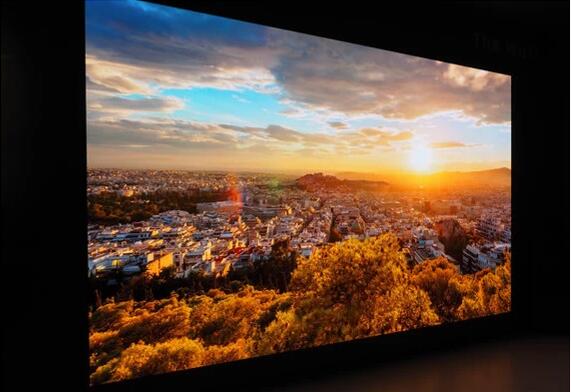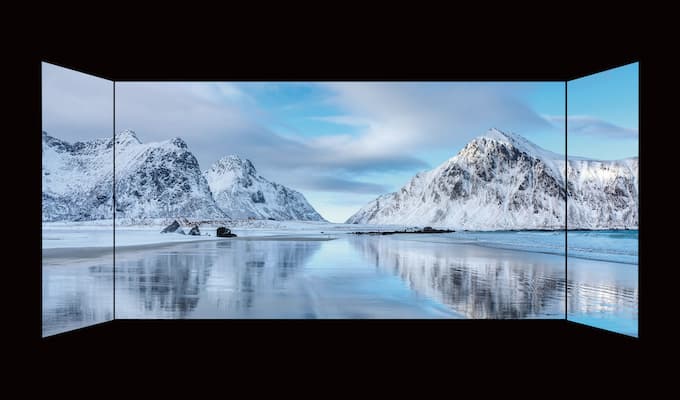Everything You Need To Know About Direct View Micro Led Display
Introduction
Galaxyavi direct view Micro LED display is a new generation of electronic device for displaying data and images. It’s a new breakthrough for direct view LED display. Micro LED displays have great advantages over traditional LED, OLED, and LCD displays.
What is direct view micro led display?
Micro LED display is a type of direct view display with hundreds of millions of micron-sized self-emitting light units.
Micro LED displays are higher resolution, low power, and high brightness displays; they have excellent contrast ratios.

Why choose micro led display?
You’ve probably heard about micro-led displays before. They have gained popularity in recent years due to their many benefits and advantages over other types of display panels.
High resolution, high contrast ratio and high brightness
Micro-LEDs can be manufactured into pixels as small as 0.6mm wide, meaning that the resolution can compare favorably with LCDs or OLEDs (called “micro” because they are smaller than other types). The contrast ratio also means that blacks appear darker and whites appear brighter on a micro-LED screen than with other technologies (which translates into better image quality).
Longer lifespan
Micro-LED displays last longer because there are no organic components inside them like those found in OLEDs or LCD panels. This means they don’t require backlighting as older technologies do – instead, the light comes directly from each pixel on its own terms.
Micro LED display vs OLED
The biggest difference between a Micro LED display and an OLED display is that micro LEDs are self-emissive, whereas OLEDs use external light sources. This means that Micro LED displays can be completely transparent while still producing full-color images.

OLED displays are made up of organic materials that emit light when electrical current passes through them. The materials are sandwiched between two electrodes and have an active layer where color filters are added for each pixel in order to produce different colors (red, green and blue). When voltage is applied across these electrodes at various points throughout the screen it causes electrons from one electrode to pass through one or more layers until they reach another electrode where they give off photons which illuminate our eyes as they hit them at certain angles relative to their position within said layers – hence why you can only see certain parts of an object when looking at it straight on versus being off center by even just slightly due to how different wavelengths interact differently with objects depending on distance from their surface area; once again: very technical stuff 😉

Advantages of Galaxyavi Micro LED
Micro LED displays to offer all the benefits of OLED displays with a better color gamut and brighter images, longer lifespan. Micro LED uses small LEDs (which can be individually controlled) to create an image. The panel is made up of millions of microscopic LEDs, each one emitting red, green, or blue light. MicroLED technology has been in development for decades but only recently has it become practical to bring the technology to market with the emergence of companies like Samsung and Sony who are using their expertise in display manufacturing to develop production lines for micro LEDs.
MicroLED screens are energy efficient because they don’t require backlights as LCDs do; LEDs are individually lit instead so there’s no need for a backlight that would consume power even when displaying a black screen. Because each pixel is individually lit by an LED, micro-LEDs offer better control over how bright each pixel should be making them ideal for HDR content where different parts of an image might need different levels of brightness.
What is a COB and GOB LED?
COB (Chip On Board) and GOB(Glue On Board) LEDs are types of LED that are integrated on the same chip as the driver IC. COB LEDs can be mounted directly to a PCB using SMT mounting techniques and are typically used in automotive lighting applications because they’re more durable than other types of LEDs. Galaxyavi Systems MicroLED is developed and produced on two LED technologies.
How to make Micro LED display panel?
Micro LED displays are made by combining multiple LED chips. The most common method is to deposit metal layers onto the back of each chip and then stack them together using a special adhesive. These are then cut into precise shapes and assembled into a panel.
Applications Of Micro Led Displays
- Micro LED displays are used in Smart City projects, Smart Office projects, and Smart Education projects. These can be used for displaying information about the city to people like traffic situations, weather updates, etc.
- They are also used in Traffic Centers and Science Centers to display information about traffic conditions or weather changes etc.
Micro LED displays are capable of reaching over 1200 pixels per inch
Micro LED displays are capable of reaching over 1200 pixels per inch. Micro LED displays are the next generation of display technology, offering higher resolution and pixel density than other types of small form factor displays.
Micro LED technology also allows for a wider range of colors, contrast ratios, brightness levels, and viewing angles. This makes it an ideal solution for high-resolution applications that require ultra-high pixel densities (greater than 1000 pixels per inch).
Conclusion
Micro LED displays are the future of display technology. They offer much more than OLED, with better image quality and lower power consumption. Micro LED displays have a wide range of use than OLEDs, which makes huge ultra-high resolution video wall ideal in science, entertainment, and technology field like data centers, science centers, traffic centers, museums, convention centers as well as for signage applications where you need higher brightness and resolution.
Others also read the following article
Want to know more about the Audio Visual Solutions?
